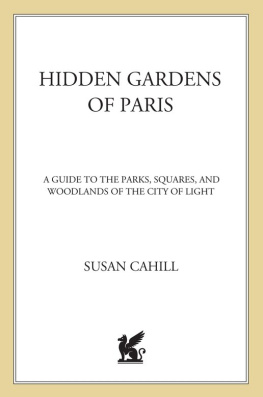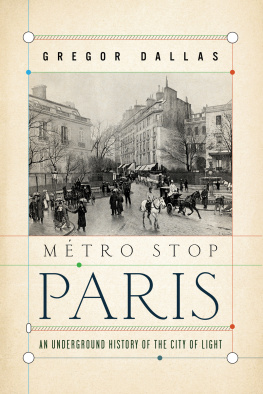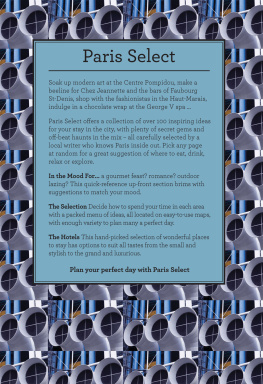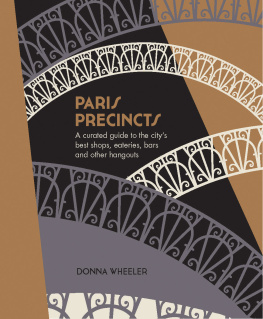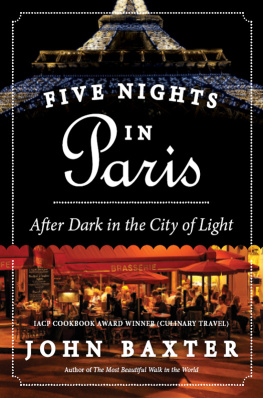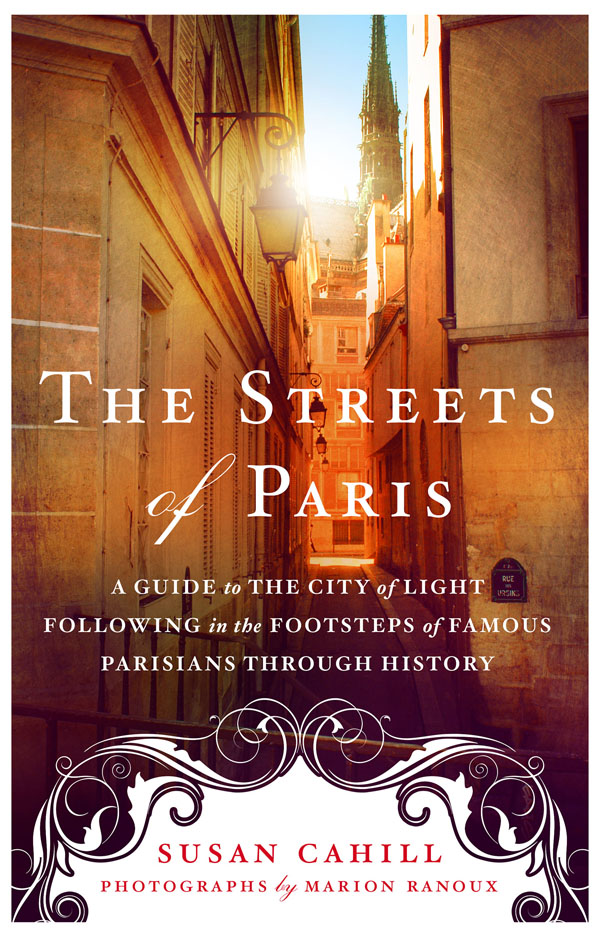Contents
Guide

The author and publisher have provided this e-book to you for your personal use only. You may not make this e-book publicly available in any way. Copyright infringement is against the law. If you believe the copy of this e-book you are reading infringes on the authors copyright, please notify the publisher at: us.macmillanusa.com/piracy.
For Joey, beloved son, and for Marion, chre belle fille
Remembering your gifts of photographs, computer wizardry, the pleasures of your hospitality and our years of walking the storied streets of the City of Light
Beauty is in the streets, they say in Paris. We travelers know our favorites, Parisians know theirs. Jean Genet liked to stand with his friend Giacometti at the foot of rue Oberkampf, taking in its long uphill from the Marais to Belleville. Simone Weil loved walking the quays of le Saint-Louis in her native river city. The scruffy streets of the ninth were Franois Truffauts muse and mother.
As cities evolve and erupt, streets change; Parisians come and go. But the beauty remains. The gray light shifts, we see from new angles the stunning mosaic that is the City of Light. One by one, the streets of Paris, their multiple personalitiescharming, broken, lyrical, dirty, elegantwind along the past and present, through the storied worlds of Parisians ancient and modern. Walking in their footsteps, we sense the hauntings of history, connect with sites of memory.
The Streets of Paris focuses on twenty-two life stories of brilliant and passionate Parisian characters in their physical settings, along the streets that tell the stories of their inspiration, of how they became the icons that Parisand historystill celebrate. In this book, the streets are stories. To paraphrase Rebecca Solnits words about the where of all our lives: Places are stories .
Travelers who love to walk in cities, searching out the backstories in the narrow old streets, are walking in imitation of so many famous people of Parisian history who also walked their city and took its street life to heart. As the Anglo-French historian and indefatigable walker Richard Cobb put it, Paris should be both walkable and walked, if the limitless variety, the unexpectedness, the provincialism, the rusticity, the touching eccentricity are to be appreciated.
With The Streets of Paris as your guide, youll walk the quartiers of such original geniuses as Patrick Modiano, dith Piaf, Colette, Jean Moulin, good king Henri IVyoull find all these names in the books Contents. Exploring the contexts of their life stories, we enter the complex mind and heart of Paris from the Middle Ages to the present. It comes through in these twenty-two portraits of writers, philosophers, lovers, patriots, royals, rebels, painters, composers, scientists, saints, and filmmakers. Each one reveals a major theme of the Parisian mosaic, the citys ambiguity, the courage and wit, the lan.
A few examples of their stories that do not show up on historical plaques or in the voice-overs of flag-waving tour guides:
Honor Daumier of Quai dAnjou on the le Saint-Louis, caricaturist, political satirist , for whom the streets of Paris were his school and college, his occupation and pastime, his career, to quote one biographer. Daumier went to jail for his subversive cartoons of the powerful.
Seventeen-year-old Hloise, the first troubadour, who, waiting for her lover Peter Abelard, hid in the shadows of the medieval Notre-Dame Cathedral Close, its winding unlit streets still winding today, a labyrinth of secrets and intrigue. Heloise is worth a thousand Abelards, said Henry James, preferring the passionate girl and her unrepentant love letters to the great medieval theologian (and father of her child) turned repentant monk.
The antifascist hero Jean Moulin of Montparnasse, leader of the French Resistence, sometime bohemian and artist, who lived a double life along the streets of southern Paris.
Albert Camus, philosopher, writer, Rsistant. He walked everywhere, Left Bank, Right Bank, recording the particulars in his Notebooks . Camus loved the world. He was uneasy with those indifferent to its beauty, wrote a recent biographer.
King Henri IV, lover, urban designer, and pluralist, made Paris a miracle of tolerance and beauty after a century of the brutal Wars of Religion. He even thought to put sidewalks on his Pont Neuf all the better for strolling and opening up what many feel is the most beautiful prospect in Paris.
Walking south, into the Latin Quarter, youll find the beloved statue of Michel de Montaigne along the rue des coles, a street dating from the Middle Ages when Paris became the academic star of Europe. The father of all enlightened moderns, Montaigne adored Paris as the inscription on his statue, a quote from his essay of Vanitie shows:
I love that citie for hir own sake I love hir so tenderly that hir spottes, hir blemishes and hir warts are deare unto me.
No sedentary philosopher, he loved to walk the streets of Paris: My business is to keep myself in motion. I walk for the sake of walking.
(Four centuries later, Julia Child echoed Montaigne. As she said in My Life in France, You learn Paris on your own two feet.)
Following in the footsteps of such Parisians, you walk the citys main geographic quartiers : le de la Cit; le Saint-Louis; the Left Bank and its quartiers (Latin Quarter, Saint-Germain); Southern Paris (Montparnasse); Western Paris (Passy); the Right Bank and its quartiers (Pigalle, Montmartre, the Marais); Northeastern Paris (Picpus, Belleville, Mnilmontant). Hitler came close to bombing the northeast into the ground because it produced nothing but insurrection, those detestable noisy unions. And windmills.
The Contents names all these areas, organizing the stories in the clear way that travelers found helpful in my book Hidden Gardens of Paris: A Guide to the Parks, Squares, and Woodlands of the City of Light . This organization is an easy plan that helps travelerswith such street maps in hand as the little red book, Paris par Arrondissements, available at most news kiosks or bookstores; and/or the folding map Streetwise Paris find their way without having to join an organized tour.
With The Streets of Paris as your guide, explorations of the city are original and leisurely rather than superficial and exhausting. (To quote Julian Green, Paris is loath to surrender itself to people who are in a hurry; it belongs to the dreamers. ) And, as many travelers and travel writers have commented in The New York Times, although they pack and carry their electronic devices, in the interests of depth and originality of content, they still buy and bring along the travel book.
Theres no need to join an organized tour if youre not in the mood; you can sit and rest your feet, eat lunch in any park or squarelike the Parisians dowhenever you feel like it. The book tells you which mtro to take (maps of the mtro are available inside the mtro stations) and which street(s) to follow on the way to your destination, say, the quiet streets of the southern Marais leading to the Htel de Sens at the end of pretty rue du Figuier where Queen Margot La Reine Margot earned her undeserved reputation as a bloodthirsty sex maniac.
A number of Parisian streets are havens of peace and solitude, perhaps unlike the tenor of the stories they tell: Reine Margots rue du Figuier . Daumiers Quai dAnjou on the north side of le Saint-Louis. Marie Curies Quai de Bthune on its south side, facing the back of Notre-Dame. On a Sunday morning, the deserted quad of Simone Weils L cole Normale Suprieure in rue dUlm . Colettes rue de Beaujolais bordering the exquisite Palais Royal.





